Effects of Ultrasonic Surface Rolling Processing and Subsequent Recovery Treatment on the Wear Resistance of AZ91D Mg Alloy
Abstract
:1. Introduction
2. Materials and Methods
3. Results and Discussion
3.1. Microstructure
3.2. Surface Roughness
3.3. XRD Analysis
3.4. Microhardness
3.5. Microstructure of the USRP-R Sample
3.6. Microhardness of the USRP-R Sample
3.7. Friction and Wear Characteristics
4. Conclusions
- (1)
- The surface grains of the USRP sample are refined to nanocrystallines with sizes ranging from 50 nm to 70 nm, and the thickness of the severe plastic deformation layer is about 190 μm. The grain refinement mechanism of AZ91D Mg alloy after USRP is twinning, dislocation slip and dynamic recrystallization.
- (2)
- Compared with the original sample, the surface roughness of the USRP sample decreases significantly from 1.283 μm to 0.118 μm. In addition, the microhardness of the USRP sample decreases along the depth direction of the cross section. The maximum microhardness of the top surface for the USRP sample reaches 102.3 HV, which is about 1.7 times the original sample.
- (3)
- The recovery treatment has effects on the microstructure and mechanical properties of AZ91D Mg alloy treated by USRP. With the increase of temperature, the thickness of the deformation layer decreases and the grains expand. The microhardness of all the USRP-R samples is lower than that of the USRP sample. The microhardness of the top surface of the USRP-R samples is 90.68 HV, 79.29 HV and 75.06 HV at the recovery temperature of 150 °C, 200 °C and 250 °C, respectively.
- (4)
- The wear resistance of the USRP sample is much better than that of the original sample, mainly due to the high microhardness. Moreover, the wear resistance of the USRP sample is further improved after a recovery treatment at 150 °C, which is attributed to the improvement of toughness. However, when the recovery temperatures are 200 °C and 250 °C, the wear resistance of the samples is poor due to low microhardness. The wear resistance of AZ91D Mg alloy depends not only on hardness but also on toughness.
Author Contributions
Funding
Conflicts of Interest
References
- Buling, A.; Zerrer, J. Increasing the application fields of magnesium by ultraceramic: Corrosion and wear protection by plasma electrolytical oxidation (PEO) of Mg alloys. Surf. Coat. Technol. 2019, 369, 142–155. [Google Scholar] [CrossRef]
- Song, J.F.; She, J.; Chen, D.L.; Pan, F.S. Latest research advances on magnesium and magnesium alloys worldwide. J. Magnes. Alloy 2020, 8, 1–41. [Google Scholar] [CrossRef]
- Gu, Y.H.; Zheng, X.H.; Liu, Q.; Ma, H.J.; Zhang, L.; Yang, D. Investigating Corrosion Performance and Corrosive Wear Behavior of Sol–gel/MAO-Coated Mg Alloy. Tribol. Lett. 2018, 66, 101. [Google Scholar] [CrossRef]
- Li, S.; Yi, L.H.; Liu, T.F.; Ji, B.; Yang, C.M.; Zhou, L.H. Al2O3 eliminating defects in the Al coating by laser cladding to improve corrosion and wear resistance of Mg alloy. Mater. Corros. 2020, 71, 980–991. [Google Scholar] [CrossRef]
- Lei, M.K.; Li, P.; Yang, H.G.; Zhu, X.M. Wear and corrosion resistance of Al ion implanted AZ31 magnesium alloy. Surf. Coat. Technol. 2007, 201, 5182–5185. [Google Scholar] [CrossRef]
- Straffelini, G.; Gariboldi, E. Sliding behaviour of hard and self–lubricating PVD coatings against a Mg–alloy. Wear 2007, 263, 1341–1346. [Google Scholar] [CrossRef]
- Vaughan, M.W.; Karayan, A.I.; Srivastava, A.; Mansoor, B.; Maier, H.J. The effects of severe plastic deformation on the mechanical and corrosion characteristics of a bioresorbable Mg–ZKQX6000 alloy. Mater. Sci. Eng. C 2020, 115, 111130. [Google Scholar] [CrossRef]
- Olugbade, T.O.; Lu, J. Literature review on the mechanical properties of materials after surface mechanical attrition treatment (SMAT). Nano. Mater. Sci. 2020, 2, 3–31. [Google Scholar] [CrossRef]
- Byun, M.H.; Cho, J.W.; Han, B.S.; Kim, Y.K.; Song, Y.S. Material Characterization of Electroplated Nanocrystalline Nickel–Iron Alloys for Micro Electronic Mechanical System. Jpn. J. Appl. Phys. 2006, 45, 7084–7090. [Google Scholar] [CrossRef]
- Rashidi, A.M.; Amadeh, A. Effect of Electroplating Parameters on Microstructure of Nanocrystalline Nickel Coatings. J. Mater. Sci. Technol. 2010, 26, 82–86. [Google Scholar] [CrossRef]
- Hwang, S.H.; Okumura, T.; Kamataki, K.; Itagaki, N.; Shiratani, M. Size and Flux of Carbon Nanoparticles Synthesized by Ar+CH4 Multi–hollow Plasma Chemical Vapor Deposition. Diam. Relat. Mater. 2020, 109, 108050. [Google Scholar] [CrossRef]
- Takahiro, M. Surface treatment and electron backscatter diffraction (EBSD) analysis of the body–centered cubic phase in Mg–Li based alloys processed by severe plastic deformation. Micron 2020, 137, 102914. [Google Scholar]
- Feng, Z.Q.; Luo, X.; Chen, Y.X.; Chen, N.; Wu, G.L. Surface severe plastic deformation induced solute and precipitate redistribution in an Al–Cu–Mg alloy. J. Alloy Compd. 2018, 773, 585–596. [Google Scholar] [CrossRef]
- Nykyforchyn, H.; Kyryliv, V.; Maksymiv, O. Wear Resistance of Steels with Surface Nanocrystalline Structure Generated by Mechanical–Pulse Treatment. Nanoscale Res. Lett. 2017, 12, 1–5. [Google Scholar] [CrossRef] [Green Version]
- Duan, M.; Luo, L.; Liu, Y. Microstructural evolution of AZ31 Mg alloy with surface mechanical attrition treatment: Grain and texture gradient. J. Alloy Compd. 2020, 823, 153691. [Google Scholar] [CrossRef]
- Zheng, H.Z.; Guo, S.H.; Luo, Q.H.; Shu, X.Y.; Li, G.F. Effect of shot peening on microstructure, nanocrystallization and microhardness of Ti–10V–2Fe–3Al alloy surface. J. Iron. Steel. Res. Int. 2019, 26, 52–58. [Google Scholar] [CrossRef]
- Patil, A.; Bontha, S.; Ramesh, M.R. Effect of ECAP on sliding wear behaviour of Mg–Zn–Gd–Zr alloy. Mater. Today Proc. 2020, 20, 97–102. [Google Scholar] [CrossRef]
- Hou, X.N.; Qin, H.F.; Gao, H.Y.; Mankoci, S.; Zhang, R.X.; Zhou, X.F.; Ren, Z.C.; Doll, G.L.; Martini, A.; Sahai, N.; et al. A systematic study of mechanical properties, corrosion behavior and biocompatibility of AZ31B Mg alloy after ultrasonic nanocrystal surface modification. Mater. Sci. Eng. C 2017, 78, 1061–1071. [Google Scholar] [CrossRef]
- Ye, Y.D.; Li, X.P.; Sun, Z.Y.; Wang, H.B.; Tang, G.Y. Enhanced Surface Mechanical Properties and Microstructure Evolution of Commercial Pure Titanium Under Electropulsing–Assisted Ultrasonic Surface Rolling Process. Acta Metall. Sin. Engl. Lett. 2018, 31, 1272–1280. [Google Scholar] [CrossRef] [Green Version]
- Divya, S.P.; Nagaraj, M.; Kesavamoorthy, M.; Srinivasan, S.A.; Ravisankar, B. Investigation on the Effect of ECAP Routes on the Wear Behavior of AA2014. T. Indian I. Met. 2017, 71, 67–77. [Google Scholar] [CrossRef]
- Xia, S.W.; Liu, Y.; Fu, D.M.; Jin, B.; Lu, J. Effect of Surface Mechanical Attrition Treatment on Tribological Behavior of the AZ31 Alloy. J. Mater. Sci. Technol. 2016, 32, 1245–1252. [Google Scholar] [CrossRef]
- Liu, H.B.; Jiang, C.H.; Chen, M.; Wang, L.B.; Ji, V. Surface layer microstructures and wear properties modifications of Mg–8Gd–3Y alloy treated by shot peening. Mater. Charact. 2019, 158, 109952. [Google Scholar] [CrossRef]
- Liu, Y.; Jin, B.; Li, D.J.; Zeng, X.Q.; Lu, J. Wear behavior of nanocrystalline structured magnesium alloy induced by surface mechanical attrition treatment. Surf. Coat. Technol. 2015, 261, 219–226. [Google Scholar] [CrossRef]
- Farshidi, M.H.; Kazeminezhad, M.; Miyamoto, H. Microstructure and mechanical properties of an Al–Mg–Si tube processed by severe plastic deformation and subsequent annealing. Mater. Sci. Eng. A 2015, 640, 42–50. [Google Scholar] [CrossRef]
- Mao, X.Y.; Li, D.Y.; Fang, F.; Tan, R.S.; Jiang, J.Q. Can severe plastic deformation alone generate a nanocrystalline structure? Phil. Mag. Lett. 2010, 90, 349–360. [Google Scholar] [CrossRef]
- Li, Q.D.; Lu, H.; Li, D.Y. Effect of recovery treatment on the wear resistance of surface hammered AZ31 Mg alloy. Wear 2019, 426, 981–988. [Google Scholar] [CrossRef]
- Chen, C.Q.; Hu, G.; Florando, J.N.; Kumar, M.; Hemker, K.J.; Ramesh, K.T. Interplay of dislocation slip and deformation twinning in tantalum at high strain rates. Scr. Mater. 2013, 69, 709–712. [Google Scholar] [CrossRef]
- Christian, J.W.; Mahajan, S. Deformation twinning. Prog. Mater. Sci. 1995, 39, 1–157. [Google Scholar] [CrossRef]
- Lu, K.; Lu, J. Nanostructured surface layer on metallic materials induced by surface mechanical attrition treatment. Mater. Sci. Eng. A 2004, 375, 38–45. [Google Scholar] [CrossRef] [Green Version]
- Yi, S.B.; Davices, C.H.J.; Brokmeier, H.G.; Bolmaro, R.E.; Kainer, K.U.; Homeyer, J. Deformation and texture evolution in AZ31 magnesium alloy during uniaxial loading. Acta Mater. 2006, 54, 549–562. [Google Scholar] [CrossRef]
- Hou, L.F.; Wei, Y.H.; Liu, B.S.; Xu, B.S. Microstructure evolution of AZ91D induced by high energy shot peening. T. Nonferr. Metal Soc. 2008, 18, 1053–1057. [Google Scholar] [CrossRef]
- Ye, H.; Sun, X.; Liu, Y.; Rao, X.X.; Gu, Q. Effect of ultrasonic surface rolling process on mechanical properties and corrosion resistance of AZ31B Mg alloy. Surf. Coat. Technol. 2019, 372, 288–298. [Google Scholar] [CrossRef]
- Armstrong, R.W.; Codd, I.; Douthwaite, R.M.; Petch, N.J. The plastic deformation of polycrystalline aggregates. Philos. Mag. 1962, 7, 45–58. [Google Scholar] [CrossRef]
- Yu, H.H.; Xin, Y.C.; Wang, M.Y.; Liu, Q. Hall–Petch relationship in Mg alloys: A review. J. Mater. Sci. Technol. 2018, 34, 248–256. [Google Scholar] [CrossRef]
- Vynokur, B.B. Influence of alloying on the free energy of austenitic grain boundaries in steel. Mater. Sci. 2006, 32, 144–157. [Google Scholar] [CrossRef]
- Andani, M.T.; Lakshmanan, A.; Sundararaghavan, V.; Allison, J.; Misra, A. Quantitative study of the effect of grain boundary parameters on the slip system level Hall–Petch slope for basal slip system in Mg–4Al. Acta Mater. 2020, 200, 148–161. [Google Scholar] [CrossRef]
- Archard, J.F. Contact and Rubbing of Flat Surfaces. J. Appl. Phys. 1953, 24, 981–988. [Google Scholar] [CrossRef]
- Somekawa, H.; Mukai, T. Effect of texture on fracture toughness in extruded AZ31 magnesium alloy. Scr. Mater. 2005, 53, 541–545. [Google Scholar] [CrossRef]
- Hwang, D.H.; Kim, D.E.; Lee, S.J. Influence of wear particle interaction in the sliding interface on friction of metals. Wear 1999, 225, 427–439. [Google Scholar] [CrossRef]


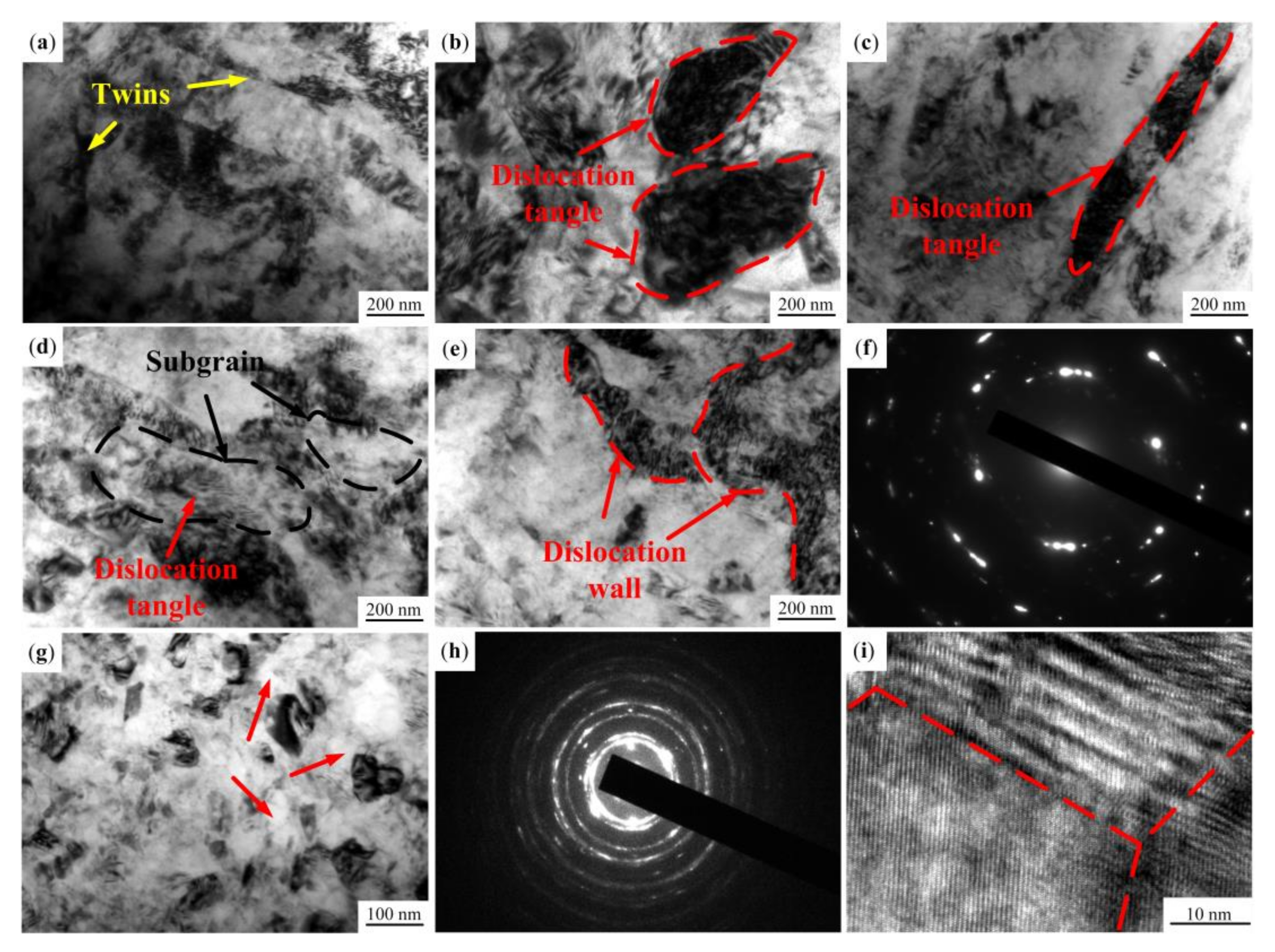
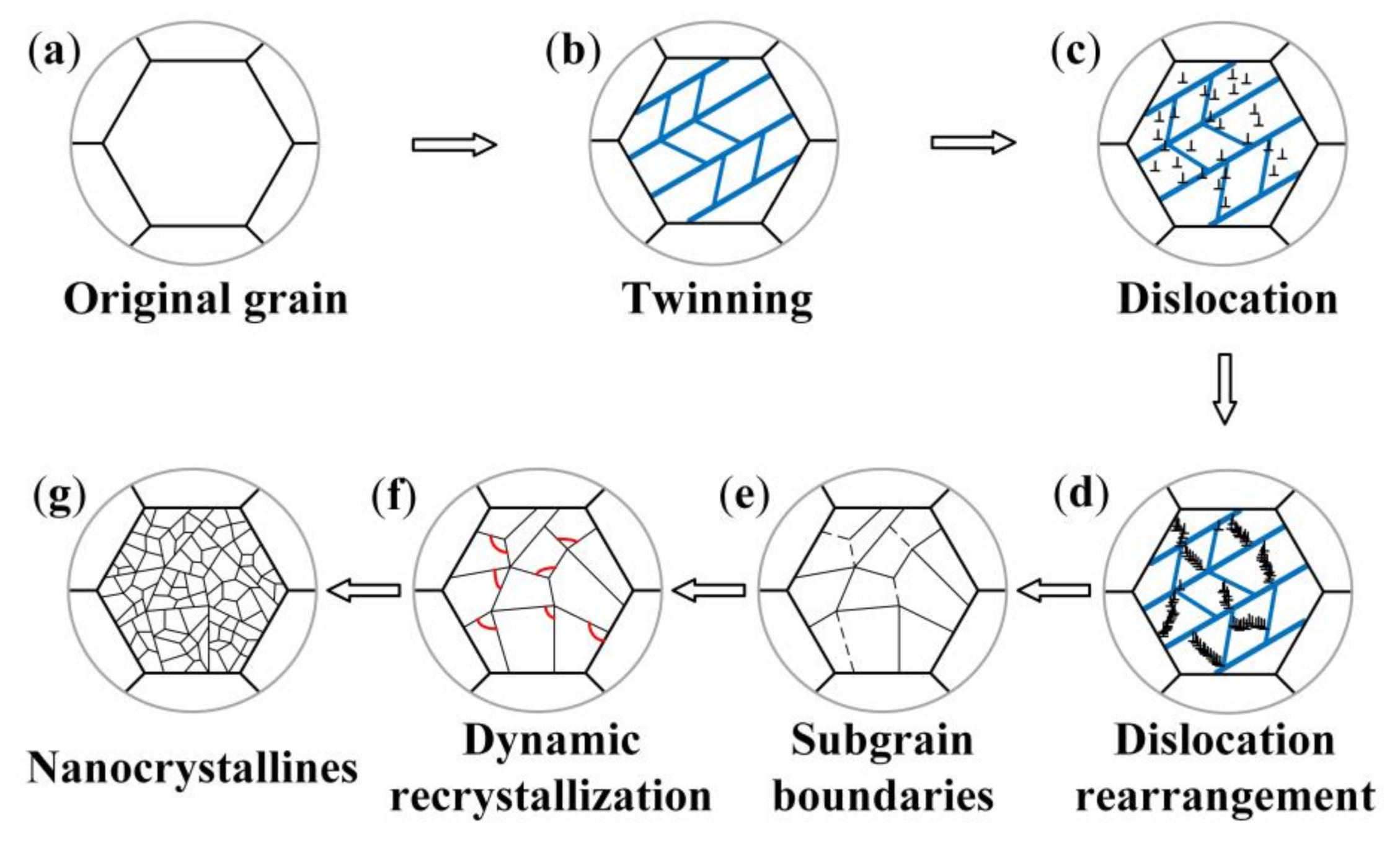



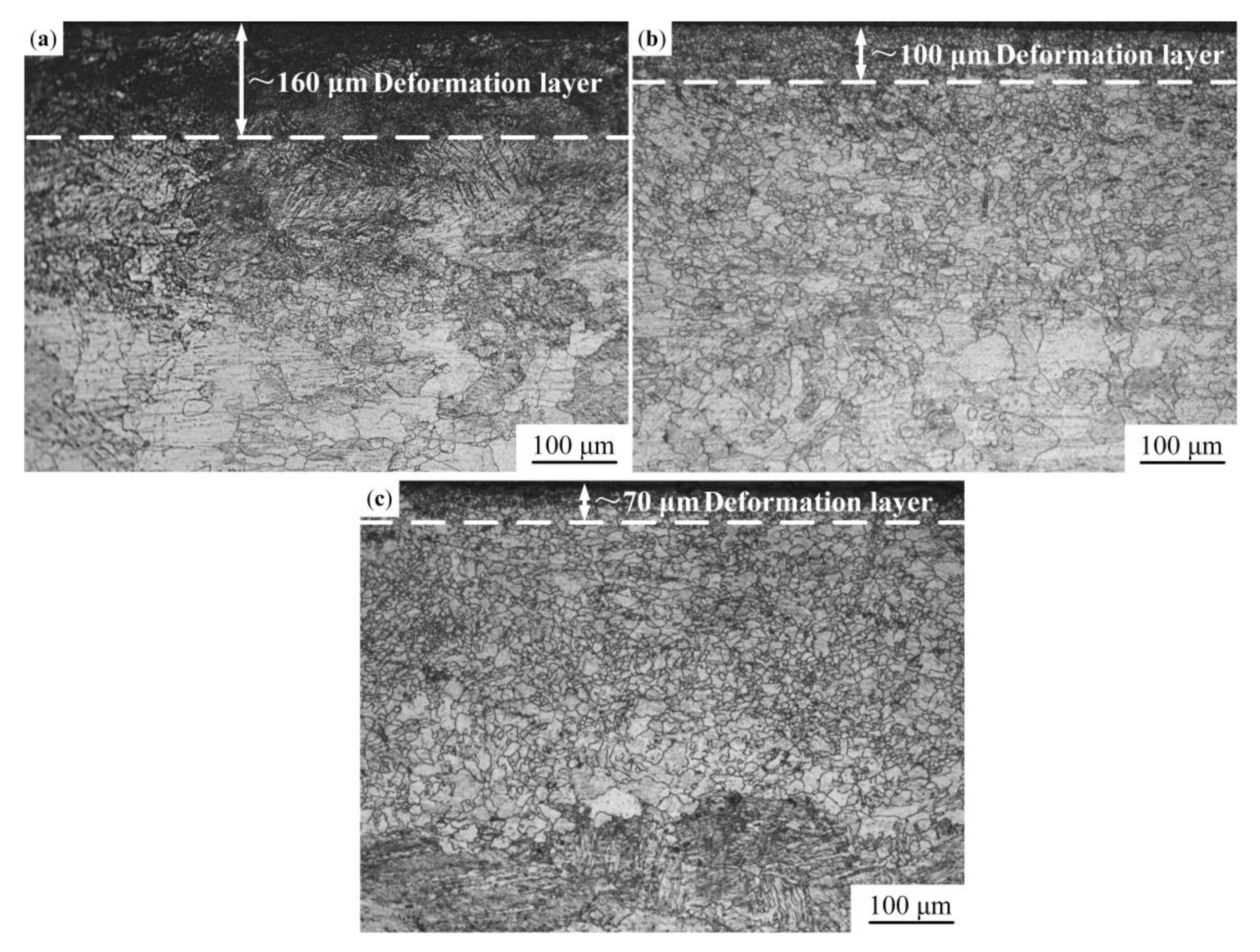


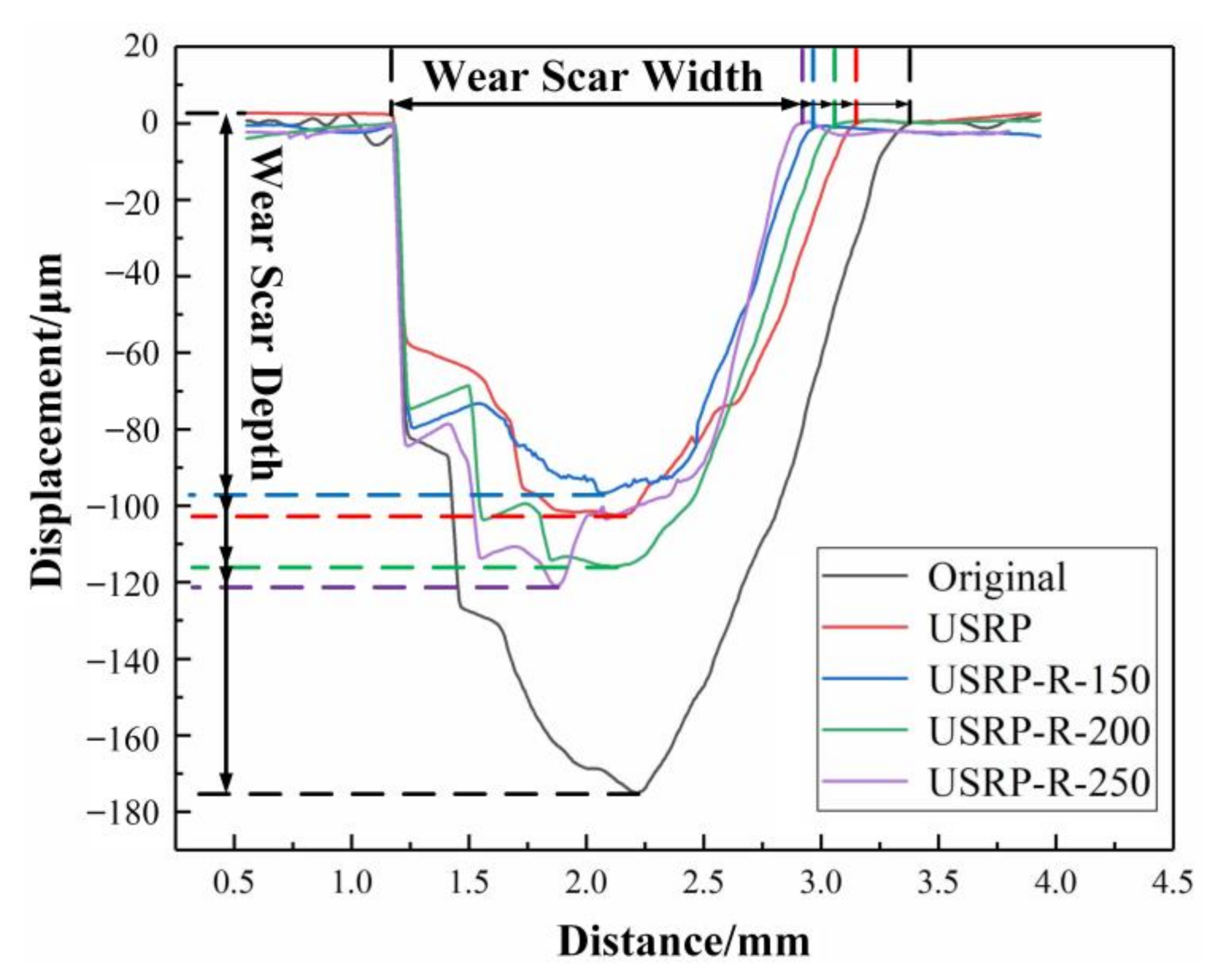

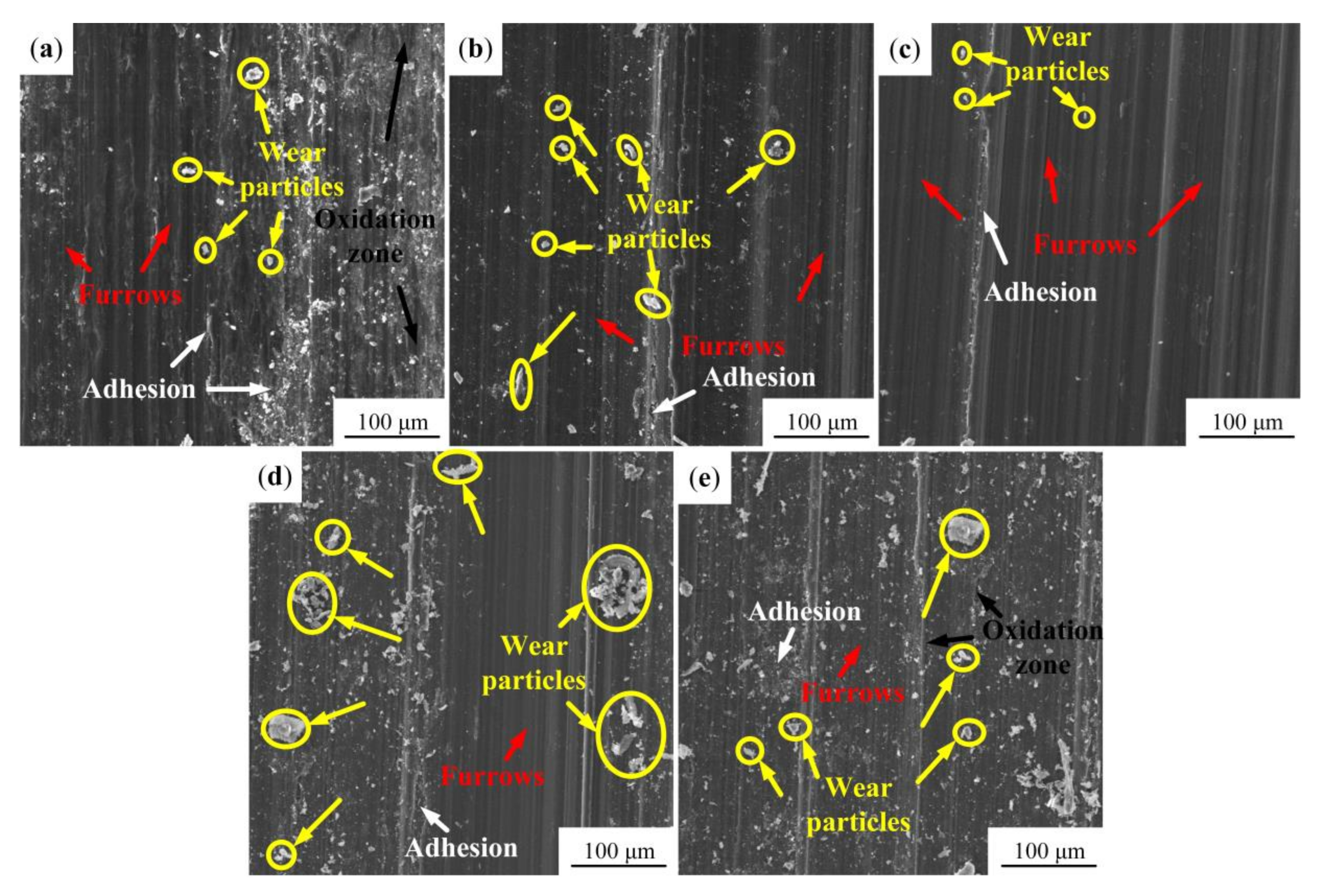

| Al | Zn | Mg | Si | Fe | Ni | Cu | Mg |
|---|---|---|---|---|---|---|---|
| 8.72 | 0.51 | 0.31 | 0.04 | 0.003 | 0.001 | 0.003 | Bal. |
| Current/A | Frequency/KHz | Amplitude/μm | Spindle Speed/r·min−1 | Load/N | Feed Rate/mm·r−1 |
|---|---|---|---|---|---|
| 0.7 | 20 | 7.5 | 80 | 240 | 0.1 |
Publisher’s Note: MDPI stays neutral with regard to jurisdictional claims in published maps and institutional affiliations. |
© 2020 by the authors. Licensee MDPI, Basel, Switzerland. This article is an open access article distributed under the terms and conditions of the Creative Commons Attribution (CC BY) license (http://creativecommons.org/licenses/by/4.0/).
Share and Cite
Zhao, X.; Liu, K.; Xu, D.; Liu, Y.; Hu, C. Effects of Ultrasonic Surface Rolling Processing and Subsequent Recovery Treatment on the Wear Resistance of AZ91D Mg Alloy. Materials 2020, 13, 5705. https://doi.org/10.3390/ma13245705
Zhao X, Liu K, Xu D, Liu Y, Hu C. Effects of Ultrasonic Surface Rolling Processing and Subsequent Recovery Treatment on the Wear Resistance of AZ91D Mg Alloy. Materials. 2020; 13(24):5705. https://doi.org/10.3390/ma13245705
Chicago/Turabian StyleZhao, Xiaohui, Kaichao Liu, Desheng Xu, Yu Liu, and Chunhua Hu. 2020. "Effects of Ultrasonic Surface Rolling Processing and Subsequent Recovery Treatment on the Wear Resistance of AZ91D Mg Alloy" Materials 13, no. 24: 5705. https://doi.org/10.3390/ma13245705




